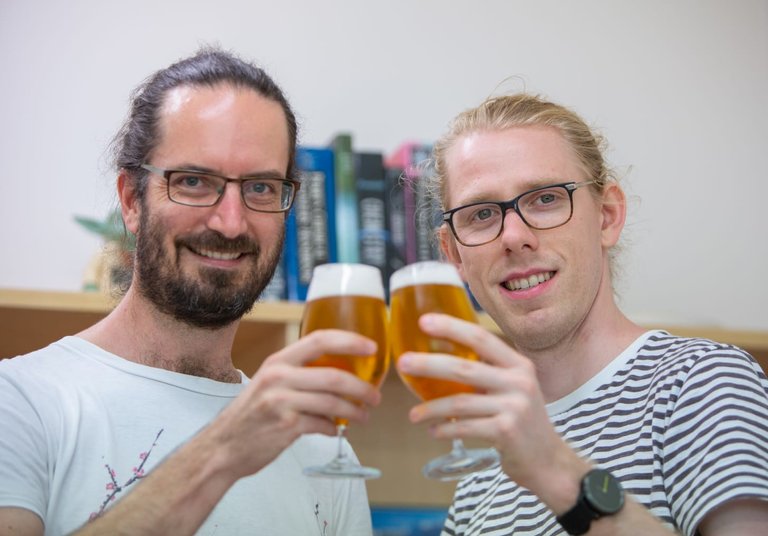A flame-side chat with A/Prof Ben Schulz about Benchtop Micro-mashing
Hello, fellow brew enthusiasts,
This week, we are having a flame-side chat with Ben Schulz, leading author of a paper entitled: “Benchtop micro-mashing: high-throughput, robust, experimental beer brewing”. Ben is an Associate Professor in the School of Chemistry and Molecular Biosciences at the University of Queensland. You can find his profile here.
We previously described this paper, which in a nutshell, established a new method that allows the evaluation of mashing parameters at a very small scale (1 mL as opposed to 23 L). Here, we will talk about where the idea came from, the technical aspects of the micro-mashing and whether it can be used to further beer recipe development.
Let’s get mashing!
Edgar: Could you tell me what prompted you to start looking into micro-mashing? Any realisation/conversation or event that resulted in your idea?
Ben: A PhD student in my group was looking at barley protein changes during the mashing stage of beer brewing. We had submitted a manuscript for peer review, and one of the paper’s reviewers asked if the changes we could measure were caused by temperature or time spent mashing the barley. To answer this we would have needed to brew all over again, with an instrument that would hold at least 23 litres of brew, including five kilograms of malt for each brew – it would have taken another three months.

First author and graduate student Edward Kerr standing next to a regular Speidel Braumeister, holding a 1.5 mL tube. Using a micro-scale approach, single (malted) seed mashing can now be used to assess mash parameters and barley quality characters.
To be honest, we were feeling a little lazy and decided to see if we could do the same experiment on a much smaller scale.
The result was surprising – we found that we could replicate the beer brewing process using only a single barley seed in a 1.5-millilitre tube.
Edgar: Surely, taking the decision required some discussion and convincing, what was your biggest worry before conducting these experiments?
Ben: Since the micro-mashing approach uses such small amounts of material it was an easy experiment to try out. We did some initial test mashes and realized that sugars and FAN looked pretty good, which gave us confidence to do the whole experiment that way.
Edgar: Your group used fairly low amounts of malted grains to scale down the protocol. Did you experience any issues with heterogeneity in your samples? If so, how did you deal with that?
Ben: We did notice that although both scales were comparable, there was some more variability at the small scale than at larger scales. One possible way we could use this method is to study the variability between single seeds, which will give some really interesting insights into barley biology.
Edgar: For your work, you used a standard recipe with pale ale malt. Is the micro-mashing technique suited for recipes that demand other grains (barley vs wheat or oat) and/or treated differently (more roasted then others)?
Ben: It would certainly be possible to micro-mash with more complex recipes. The only difficulty would be mixing the small number of grains!
Edgar: To what extent would you think you can miniaturize the entire brewing process?
Ben: We have studied germination at a single seed level (https://doi.org/10.1101/2020.06.02.130823), which is very similar to malting; and yeast fermentation can be done at very small scales as well, so I’d think there be plenty of opportunities to miniaturize the whole process. This could be used for all sorts of process trials and optimization, as long as the analytical sensitivity fits.
Edgar: How do you see this work advance the efforts of (small) breweries and home brewers?
Ben: It’s probably not really immediately useful for homebrewers unless they’re after very, very small batches!
Edgar: How is micro-mashing different from Congress mashing? Don't they have the same purpose?
Ben: The purpose is certainly very similar – quality control or malt characterisation on a small scale. The difference is just the scale – down to a single malted barley seed!
Edgar: What was the biggest hurdle or bottleneck in your research?
Ben: Now that it’s so easy to mash at a small scale, we can test so many different conditions that the downstream systems biology analytics becomes the bottleneck. This also opens up opportunities for streamlining these analytics, once we know what is most interesting to measure to judge different aspects of wort or beer quality.
Edgar: What is the next step or question that you are now trying to address?
Ben: One thing that’s currently much slower than mashing or systems biology analytics is breeding and growing barley. We think that being able to measure mashing performance with a very small number of seeds will allow us to help breeders make decisions early in their growth cycles, to speed up the whole process.

A/Prof Ben Schulz (L) and first author Edward Kerr (R) evaluating the fruits of their hard work in the lab
Edgar: As a scientist-brewer, what sort of advance does the field need to genuinely impact beer making? What do you think brewers need?
Ben: Brewers are an amazingly creative bunch, and don’t really need science to help make tasty, exciting new beers. I think where beer science can really help is in understanding the underlying principles behind what goes on during brewing and fermentation, to improve consistency.
Edgar: Thank you so much for a very stimulating flame-side chat. I can’t wait to learn how micro-mashing will impact brew research!
Edgar, The Beerologist.
Edgar Huitema is a Scientist, Brewer & Scientific Consultant at ExtrAnalytics. Subscribe to my free newsletter to get the latest advances in science. Contact me if you wish to discuss your needs and our research.